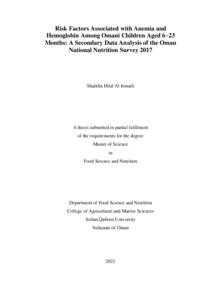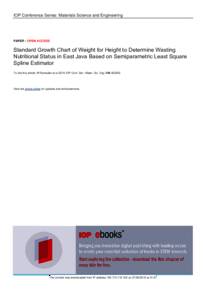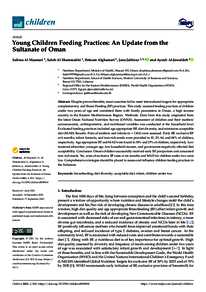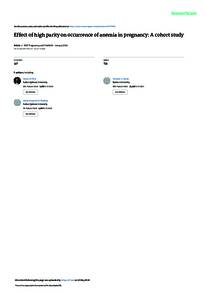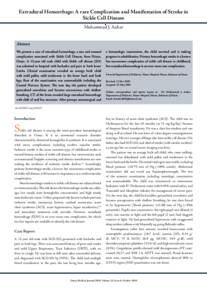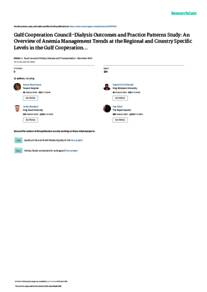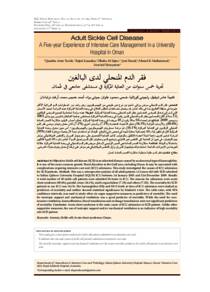وثيقة
Risk factors associated with anemia and hemoglobin among Omani children aged 6–23 months : a secondary data analysis of the Oman National Nutrition Survey 2017.
عناوين أخرى
عوامل الخطر المرتبطة بفقر الدم والهيموجلوبين بين الأطفال العمانيين الذين تتراوح أعمارهم بين 23-6 شهر : تحليل ثانوي لبيانات المسح الوطني للتغذية العماني 2017
الناشر
Sultan Qaboos University.
ميلادي
2021
اللغة
الأنجليزية
الملخص الإنجليزي
Anemia is one of the most common diseases among children and is
considered a global health problem. The World Health Organization (WHO)
estimation in 2011 indicated that the highest prevalence of anemia was in children
aged 6–59 months (42.6%, 95% CI: 37–47). In Oman, anemia in children aged 6–59
months is classified as a severe public health problem with a prevalence of 41%
(95% CI: 18–63). Although anemia in children represents a challenging health
concern in Oman, no studies have been conducted to examine anemia risk factors
among Omani children. Such studies might contribute to formulating prevention and
mitigation actions to address anemia in Oman. Therefore, this study examined child
and maternal risk factors associated with anemia and hemoglobin (Hb) among Omani
children aged 6–23 months.
The study used the most recent data from the Oman National Nutrition
Survey (ONNS) 2017. A total of 679 child-mother pairs were included in the study.
Anemia (Hb < 11.0 g/dL) and Hb concentration (g/dL) were the dependent variables
examined in the study. The study examined the distribution of anemia across
different groups of independent variables. Bivariate logistic regressions were
performed to assess the association between anemia and different child, maternal,
and household factors. One-way analysis of covariance (ANCOVA) was performed
to examine the effect of child dietary diversity on Hb levels after controlling for child
and maternal factors. Furthermore, two-way ANCOVA was performed to examine
the effect of child dietary diversity and age on Hb after controlling for child and
maternal factors.
The prevalence of anemia in the study children was 36.5% with a mean Hb
concentration of 11.2 ± 1.13 g/dL. A significant negative association was found
between the age of children and anemia (OR = 0.95, 95% CI: 0.93–0.99, p = .01).
The remaining factors (child dietary diversity, weight-for-height Z-score, gender,
birthweight, family size, and family monthly income) showed no significant
association with anemia (p >.05). Similarly, the one-way ANCOVA test revealed no
significant effect of child dietary diversity on Hb after controlling for child and
maternal factors (p >.05). Finally, the two-way ANCOVA also revealed no
significant effect of the interaction of child diet (dietary diversity) and age on Hb
after controlling for child and maternal factors (p >.05).
In conclusion, the prevalence of anemia among Omani children aged 6–23
months was high. Only child age was identified to have a significant negative
relationship with anemia. Despite controlling for different child/maternal factors, Hb
was not influenced by dietary diversity or age. Therefore, further studies and surveys
are required to identify other factors shaping the high prevalence of anemia at this
critical age in Oman.
المجموعة
URL المصدر
الملخص العربي
يعد فقر الدم من أكثر الأمراض شيوعا بين الأطفال، وهو مشكلة صحية على مستوى العالم؛ فقد أشارت تقديرات منظمة الصحة العالمية )WHO )عام 2011م إلى أن أعلى معدل النتشار فقر الدم كان في الأطفال الذين تتراوح أعمارهم بين )59-6( شهًرا )،٪42.6 37-47 :CI 95%). ويُظهر هذا التقدير إلى أن ُعمان هي إحدى الدول التي يُصنف فيها فقر دم الأطفال في عمر )59-6( شهًرا كمشكلة صحية عامة حادة، )،٪41 18-63 :CI 95%). ومع أهمية المشكلة الصحية المذكورة، وفعالية تأثير مخرجات الدراسات في صياغة الأجراءات الوقائية في انتشاره، الأ أنه ال توجد دراسة أجريت لفحص عوامل خطر الأصابة بفقر الدم بين الأطفال العمانيين. لذلك، كان الهدف من هذه الدراسة هو: استقصاء عوامل الخطر لألطفال والأمهات المرتبطة بفقر الدم والهيموجلوبين )Hb )بين الأطفال العمانيين الذين تتراوح أعمارهم بين )23-6( شهًرا. ُ عدة إجراءات انتهجت الدراسة أساسية؛ فقد استخدمت أحدث البيانات من المسح الوطني للتغذية العماني 2017 (ONNS(، و ُضّمنت مجموعة من 679 من الأطفال وأمهاتهم في الدراسة. واختير فقر الدم )الهيموجلوبين dL/g 11.0 )< p). وفي المقابل، مع اختبار تحليل التباين المشترك ANCOVA أحادي الأتجاه، لم يكشف عن أي تأثير للتنوع الغذائي لألطفال على الهيموجلوبين. وأظهر تحليل التباين المشترك ANCOVA ثنائي الأتجاه -أي ًضا- عدم وجود تأثير للتفاعل بين النظام الغذائي لألطفال )التنوع الغذائي( والعمر على الهيموجلوبين، بعد التحكم في عوامل الطفل والأم على الأختبارين ).05< p). وأخي ًرا، فبالرغم من أن انتشار فقر الدم بين الأطفال العمانيين الذين تتراوح أعمارهم بين 23-6 شهًرا: كان مرتفعًا، فلم تستطع الدراسة التوصل الأ إلى عامل واحد -فقط- له عالقة مع فقر الدم، وهو: عمر الطفل. وعلى الرغم من التحكم في عوامل الطفل والأم المختلفة، لم يتأثر الهيموجلوبين بالتنوع الغذائي أو العمر. ويتأكد من ذلك الحاجة إلى مزيد من الدراسات والمسوحات لتحديد العوامل الأخرى التي تشكل ارتفاع معدل انتشار فقر الدم بين هذا العمر الحرج في عمان.
قالب العنصر
الرسائل والأطروحات الجامعية

